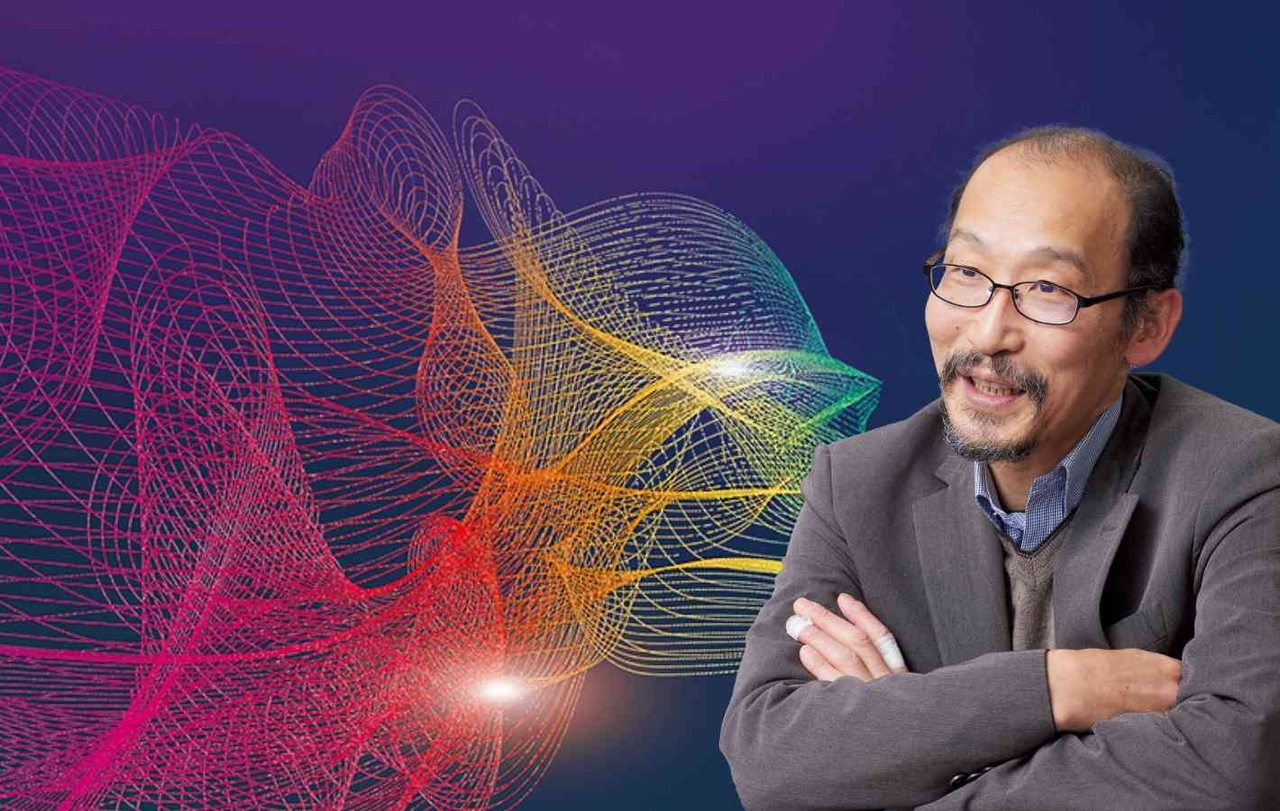
Technology that creates the world
Holography captures the 3D optical information and reproduces objects as 3D images. It has already permeated society, being widely applied in areas such as anti-counterfeiting, design, and art. However, holography in which a life-size moving 3D image is projected in front of your eyes, is still a fiction that you can only see in movies. Professor Masahiro Yamaguchi has spent years working on the acquisition of optical information reflected from objects as digital data and on interfaces to reproduce that information for human eyes. We explore his work on this invisible yet remarkable path of light.
Digitally creating holograms that surpass analog recording
An object is visible when our eyes receive light reflected by the object. When recording light, an ordinary camera captures the intensity and wavelength (color) of the light but loses depth information. Holography is a technology that records and reproduces not only the intensity of light but also the information on how light travels as waves, i.e., phase information. Hence it can capture and reconstruct an object as a 3D image, including depth information. The recorded medium taken with holography is called a hologram. The inventor of holography, Dennis Gabor, received the Nobel Prize in Physics in 1971.
In the 1980s, when I was a fourth-year undergraduate student, it was common to create holograms by an analog process. The area I chose as my research field, the creation of holograms from digital data, had just begun. In the analog method, since the object needs to be stable during recording under laser light illumination in a darkroom, it is not possible to record large or soft objects, and of course, it is not possible to create holograms of virtual objects. I thought that it would be a wonderful way to bring the image in my mind to reality as a 3D image if I could create a hologram from computer-generated data. For the digital holograms that I am currently researching, it is necessary to calculate how light is reflected and propagated from objects in the real world, so we employ a computer to perform a simulation of how light travels. Holograms created in this way are called computer-generated holograms (CGH), but it is impossible with the methods established so far to fully simulate the complex behavior of light that interacts with various types of object surfaces and arrives at the hologram plane. Therefore, we are currently researching a method to create elaborate holograms by incorporating CG technology and using two different representations of optical information, light rays and waves[1], in appropriate combinations. The CGH of diamonds recently created using this method beautifully reproduces the luster, brilliance, and complex refraction of light.
Ultimate reality - one of the final destinations of holograms
"Out of the types of information that humans receive from the real world, the largest volume is optical information. How can we digitize the light in the real world and reproduce it to human eyes? It is a rewarding field where the results are truly 'visible.'"

He received his M.S. from Tokyo Institute of Technology, Department of Information Processing, Interdisciplinary Graduate School of Science and Engineering in 1989. He became a professor at the university's Global Scientific Information and Computing Center in 2011, and has been at his current position since 2016. He received his Ph.D. from Tokyo Institute of Technology in November 1994. For about 10 years from 1999, he was involved in research on natural color reproduction imaging systems using spectral technology as a sub-leader of the Akasaka Natural Vision Research Center at the National Institute of Information and Communications Technology. He is currently promoting international collaborations related to spectroscopic imaging as a research forum RF-1 convener of the International Commission on Illumination (CIE).
The holograms we make are mainly recorded as still images on glass plates or film. Displaying holograms on electronic displays requires over 100K pixels, well beyond the current 4K and 8K, so it has not yet been implemented in the real world. If it can be achieved, you will be able to enjoy a completely different visual experience from today's TVs with the naked eye.
My current goal is to reproduce a life-size human being and the entire space of a room using digital holograms. We are also conducting joint research with other research institutes, and we have just completed a full-sized human head. Today, AR and VR worlds are expanding, but what makes holograms special is that they allow you to sense a natural 3D space with the naked eye. We will continue to study optical information in pursuit of truly realistic visual expression in 3D space.
What exactly is a hologram?
When you hear the word "hologram," you might imagine a 3D image floating in the air. That's not wrong, but the seemingly 3D computer-generated characters you see at concerts are not created by holography, but are 2D images using a transparent screen. The most familiar hologram in Japan is the rainbow-colored part of the yen banknote. The new 10,000 yen and 5,000 yen notes to be issued in 2024 will also have holograms that will make the portraits look 3D.
Holography is even used in AR glasses
Holography is also used in augmented reality (AR) glasses that add new visual and text information to real-world images. The 3D image display in current AR glasses is not holography, but holograms are used as an optical element that synthesizes real-world scenes and the image from the projector. In addition, since conventional 3D images force an adjustment of the eye's focusing that is different from usual, viewers are susceptible to eye fatigue. Applying holography, which can perfectly reproduce the light emerging from an object, will eventually enable a more natural visual experience.
A future where you can "touch" 3D aerial images
Development is underway on 3D user interfaces that are controlled by "touching" a 3D aerial image created by holography. When you bring your finger to the 3D image, a sensor detects the position where the finger touches the image and controls the system. It is intuitive and easy to understand because you manipulate the image in the air directly. The system is also effective in preventing dirt and infection because your finger does not touch a display. Now we just need to wait for its commercialization as a novel human-computer interface.
Humans do not perceive three-dimensionality solely from the discrepancy between the vision of the left and right eyes. The intrinsic value of holograms is to present the same optical information as the real objects to human eyes.
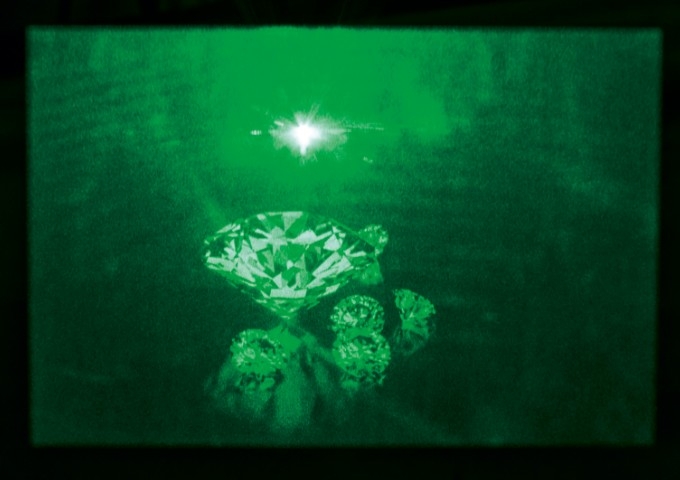
Computer-generated hologram of diamonds
Holography is a technology that records and reproduces phase information in addition to light intensity. Two different beams are required for recording: the beam reflected from the object (object beam) and the beam that directly irradiates the recording medium without hitting the object (reference beam). A phenomenon called interference occurs in which the intensity of light changes due to the superimposition of the waves of the reference beam and the object beam. The interference of light waves creates a very fine fringe pattern in the recording medium. The medium on which the resulting interference fringes are recorded is a hologram. When the hologram is illuminated by the beam from a light source placed at the same position as the reference beam at the time of recording, the light is diffracted[2] by the interference fringes of the hologram, generating light traveling in a different direction. The diffracted beam at this time has the same form as the recorded object beam. Based on this principle of holography, the observer sees the 3D image as if the original object were behind the hologram, even though the object is not really there.
Holography was invented by Hungarian-born physicist Dennis Gabor in 1948, but it remained unnoticed for a long time because it did not produce clear images. However, the invention of the laser in 1960 improved the quality of reproduced images, and holography has developed into a foundational technology.
Hologram recording and image reconstruction seen from the optical path diagram "of a laser beam"
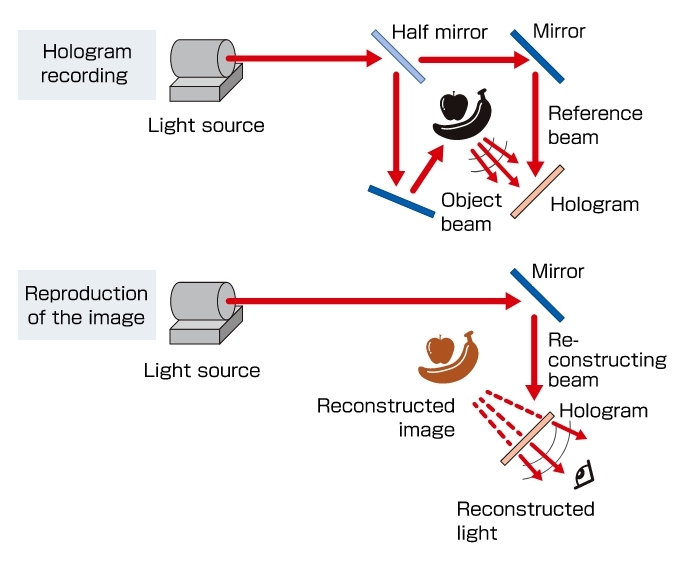
Hologram recording uses a laser that emits light of only one wavelength. The emitted beam is separated by a half mirror into two beams; one irradiates the object and the other directly irradiates the recording material (reference beam). Then the reflected beam from the object (object beam) and the reference beam are superimposed and expose the recording medium. The interference fringe of the object and reference beams is recorded in a hologram. When reconstructing the hologram, by irradiating the hologram with a laser beam from the same position as the reference beam in recording, the light diffracted by the interference fringes of the hologram travels in the same way as the light emitted from the original object. It therefore looks as if the original object is floating as a 3D image.
Expanding applied research
Yamaguchi stands at the forefront of research on digital hologram production.
"At the time I started my research, people would display hundreds of computer-generated images with a cathode ray tube, record it on movie film, and then expose it with a laser beam to create a hologram of image objects. It was an incredibly time-consuming task. My first research topic was to create holograms by displaying images on LCD TVs instead of film. Our starting point of digitizing optical information has not changed, but we also focus on a variety of applied research that has emerged during the research process."
Reproducing colors as seen by the naked eye
Since a basic hologram utilizes the diffraction of light, if sunlight or white light different in wavelength and direction from the reference beam is used as the reconstructing beam, the 3D image will be blurred. A "rainbow hologram" is a typical example that reproduces this by using the spectrum of light. In the light spectrum, the light is dispersed into different wavelength components, so the reproduced image changes its color like a rainbow depending on the position of the eye. It is printed on credit cards and banknotes, as it is effective in preventing counterfeiting because it is difficult for third parties to duplicate.
As part of his applied research, Yamaguchi is developing image technology that makes full use of spectral information to capture and display images instead of the conventional RGB primary colors in color cameras and displays, namely, spectral imaging and multi-primary color display. If a camera can capture and display the spectrum[3] of light, it will be possible to capture colors and reproduce them exactly as seen by the naked eye on a display.
"Color reproduction technology with accurately capturing color, texture, and gloss of an object has the potential to make particularly significant contributions to medicine. For example, dermatologists need to distinguish slight color differences in lesions, but normal commercial cameras correct the skin complexion and output images in beautiful colors. Representing it with spectral information allows for subtle shades to be correctly identified. By applying image processing that enhances a specific wavelength component, it is possible to emphasize the lesion. Also, carrying a spectroscopic camera may dramatically improve the quality of telemedicine in sparsely populated or remote areas. In addition to medicine, the range of possible uses is expanding in many ways, such as creating digital archives of artworks and cultural heritage, and sharing the images of product prototypes." (Yamaguchi)
Next-generation technology, the "lensless camera"
Invented by Dennis Gabor, holography was originally intended to capture and reproduce the properties of waves without a lens in order to create X-ray and electron beam microscopes, for which lenses cannot be used. For this reason, holograms are sometimes called "lensless photography." Compact, lightweight, and capable of recording 3D information about objects, the lensless camera has been in high demand in recent years as an image sensor for next-generation AI. It is actually an extension of hologram technology.
In March 2022, Yamaguchi and his lab members announced a new image reconstruction method for lensless cameras using a cutting-edge machine learning technique called a Vision Transformer (ViT). This groundbreaking method speeds up the image processing of lensless cameras and enables the capture of high-quality images.
"Lensless cameras have the potential to allow changing focus even after an image has been captured, based on the optical information recorded. The technology for reconstruction from captured images is the key. There have already been attempts to apply deep learning, which has been developing remarkably in recent years; but it was not suitable for the special characteristics of the optical system of lensless cameras, so sufficient performance was not achieved. In the method we developed, we focused on the fact that a ViT can represent the characteristics of a lensless camera well, and overcame that challenge." (Yamaguchi)
Based on optical imaging and image processing technology, Yamaguchi Lab conducts a wide variety of research, including multispectral imaging and lensless cameras. All of their research is conducted to meet the needs of the times, and Yamaguchi says that he wants the technology to see the light of day. Imaging engineering enables us to express invisible information in a form that can be seen with the naked eye, so we can experience the wonders of technology at a glance. Through the work of researchers like Yamaguchi, the ultimate image will one day cease to be a dream and will instead be projected right before our eyes.
"Innovative" Lensless camera awaiting real world implementation
A lensless camera encodes the light emitted from a subject through a special sheet-like mask instead of a lens and records it as a pattern on the sensor. For cameras, this technology offers miniaturization, lower cost, and higher functionality; but processing has proven to be a challenge. The new image processing method by Yamaguchi Lab has the potential to immediately bring lensless cameras to commercialization. In the near future, we may find ultra-compact devices used in unprecedented applications throughout society.
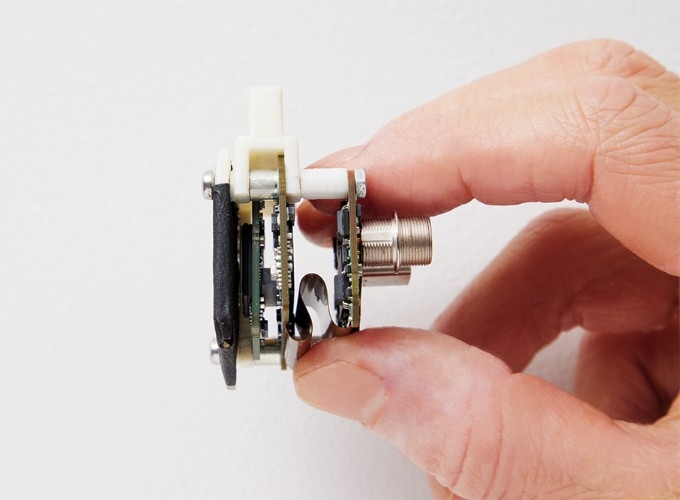
Lensless camera
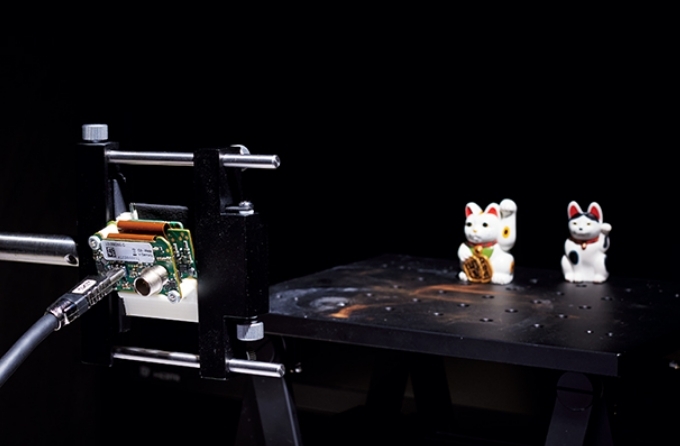
Experimental setup of a lensless camera
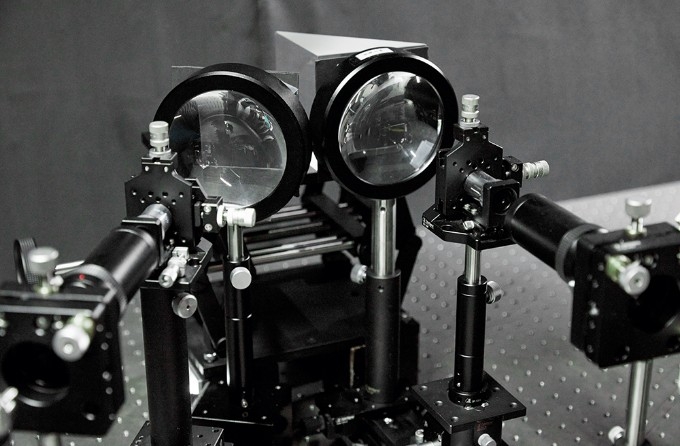
Experimental setup for recording a hologram
Terms
[1]
Rays and waves : A light ray is a concept in geometric optics and represents the path of light as a line. Actual light also has the property of wave, oscillating as a wave as it travels.
[2]
Diffraction of light : A phenomenon peculiar to waves in which when a light wave hits an obstacle, it not only travels straight, but also propagates around the area behind the obstacle.
[3]
Spectrum : A representation of a wave, such as light or a signal, decomposed into component wavelengths.
. Any information published on this site will be valid in relation to Science Tokyo.










